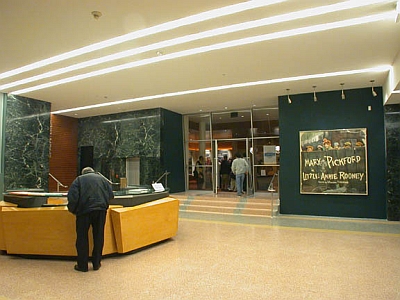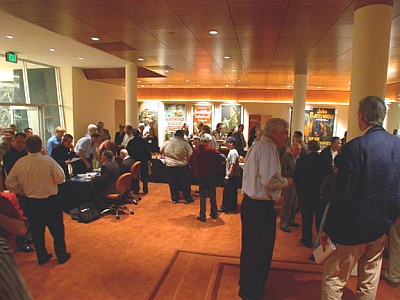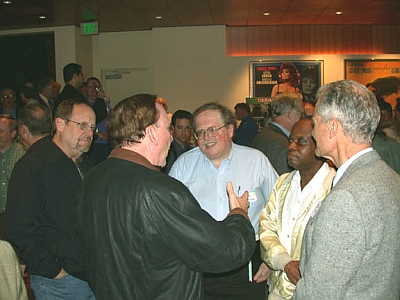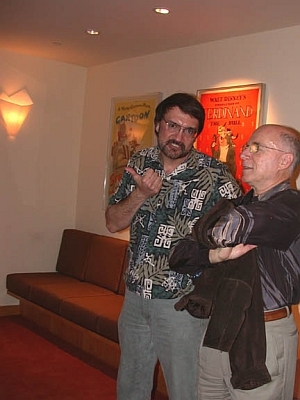An Historical Overview Of Wide Screen Motion Pictures |
Read more
at in70mm.com The 70mm Newsletter |
| Written and photographed by: Richard Greenhalgh | Date: March 17, 2004 |
 Taking advantage of the versatile projection facilities in the Linwood Dunn Theater at the Academy of Motion Picture Arts and Sciences Pickford Center, the Hollywood SMPTE Section was treated to film clips from some of the earliest pictures filmed in wide format through CinemaScope, VistaVision, 70mm and Imax. Taking advantage of the versatile projection facilities in the Linwood Dunn Theater at the Academy of Motion Picture Arts and Sciences Pickford Center, the Hollywood SMPTE Section was treated to film clips from some of the earliest pictures filmed in wide format through CinemaScope, VistaVision, 70mm and Imax.David Wiswell, Section Chair, introduced Dick May who did his usual great job of putting the meeting together. He introduced David Browning who gave a brief overview of the subject by introducing many clips. |
Further
in 70mm reading: SMPTE Meeting #2 Internet link: HOLLYWOOD SECTION MEETING Tuesday, March 16, 2004 - 8:00pm (Snacks at 7:00pm) Academy of Motion Picture Arts and Sciences Pickford Center Linwood Dunn Theater - 1313 N. Vine St |
 Starting with
"Gone With the Wind" (MGM 1939), he explained that producer David O. Selznick had considered filming the burning of Atlanta in a special two-projector process but later decided against it, believing that the story was strong enough on its own. Mr. Browning said that Selznick did use a technique he called Cycloramic with Cyclophonic Sound (more commonly known as Magnascope) in a
"Portrait for Jenny" (Selznick Releasing 1948).
Starting with
"Gone With the Wind" (MGM 1939), he explained that producer David O. Selznick had considered filming the burning of Atlanta in a special two-projector process but later decided against it, believing that the story was strong enough on its own. Mr. Browning said that Selznick did use a technique he called Cycloramic with Cyclophonic Sound (more commonly known as Magnascope) in a
"Portrait for Jenny" (Selznick Releasing 1948).The large audience was then shown a restored 35mm reduction clip from the early 70mm B&W wide screen film, "The Bat Whispers" (UA 1930). After mentioning the advent of the modern wide screen ear beginning with "This is Cinerama" (Cinerama 1952) a 35mm reduction clip from "How the West Was Won" (MGM 1962) was shown. Many in the audience had been in attendance last year [2002] when SMPTE sponsored a special showing of " How the West Was Won" at the Cinerama Dome in its full 3-projector glory. |
AN HISTORICAL OVERVIEW OF WIDE SCREEN MOTION PICTURES Taking advantage of the versatile projection facilities in the Dunn Theater, the session will be illustrated with film clips from some of the earliest pictures filmed in wide format, up through CinemaScope, VistaVision, 70mm and Imax. Archival footage will be provided by the Academy Film Archive, and studios that were involved in the wide-screen revolution. |
 A clip from "The Robe" (20th Century-Fox 1953), the fist CinemaScope film, followed. This appeared to be the same pint which was shown last year at the Egyptian and at the Bradford Wide Screen Weekend in England. Theaters at that time were required by Fox to spend $25,000 ($175,000 in today's dollars) to put in new lenses, a new screen and a new 4-track sound system to show CinemaScope films. Todd-AO followed with its superior 70mm / 30fps system. A disappointing 35mm reduction clip from
"Around the World in 80 Days" (UA 1956) was shown to illustrate this process. A clip from "The Robe" (20th Century-Fox 1953), the fist CinemaScope film, followed. This appeared to be the same pint which was shown last year at the Egyptian and at the Bradford Wide Screen Weekend in England. Theaters at that time were required by Fox to spend $25,000 ($175,000 in today's dollars) to put in new lenses, a new screen and a new 4-track sound system to show CinemaScope films. Todd-AO followed with its superior 70mm / 30fps system. A disappointing 35mm reduction clip from
"Around the World in 80 Days" (UA 1956) was shown to illustrate this process.MGM and other studios soon began to release CinemaScope films as the requirements for theatrical distribution were relaxed to allow mono sound and the use of standard screens. A nice clip from "Kismet" (MGM 1955) was shown to illustrate some of their early CinemaScope musicals followed by the entertaining Walt Disney Cartoon, "Grand Canyonscope", (Disney 1954) featuring Donald Duck. The short, "MGM Jubilee Overture", (MGM 1954) was then shown which was released as part of Metro-Goldwyn-Mayer's 30th anniversary. There are no existing scope prints of this medley of eleven well-known songs used in some of the studio's best-known musicals but the 1.85:1 Technicolor IB copy print was pleasing, even with its mono sound track. |
CARRY YOUR SMPTE CARD Entrance to SMPTE Hollywood Section meetings is free only to SMPTE members on presentation of your current membership card. Non-members are welcome, but a fee of $10 (cash only) per meeting may be charged. Please verify that your membership information, including your e-mail address, is up to date in the SMPTE Member Directory in the Members-Only section of the SMPTE website: www.smpte.org to be sure of free entrance to the meetings and to receive meeting notices. |
 Many other wide screen processes were being developed at this time, including Paramount's VistaVision 8-perf horizontal process. An original Technicolor IB clip from
"The Ten Commandments" (Paramount 1956) was shown which appeared to be the same print which was shown at the Egyptian last year when Charlton Heston was in attendance. Many other wide screen processes were being developed at this time, including Paramount's VistaVision 8-perf horizontal process. An original Technicolor IB clip from
"The Ten Commandments" (Paramount 1956) was shown which appeared to be the same print which was shown at the Egyptian last year when Charlton Heston was in attendance.David Keighley of DKP 70mm (Santa Monica, CA) then introduced the IMAX large format films which stared in the early 1970s with their 70mm 15perf horizontal format films. A 35mm reduction clip from the IMAX 3-D production of "Space Station 3-D" (IMAX 2002) was shown. There have been over 250 IMAX films made, 150 of which are still in distribution in 240 IMAX theaters world wide. The evening ended with another showing of the Academy's 70mm clip reel which was shown last year at their History of Color in Motion Pictures meeting. This reel includes a disappointing 3rd generation clip from "Lawrence of Arabia" (Super Panavision 70 - Columbia 1962), a very pleasing clip from "The Sound of Music" (Todd-AO - 20th Century-Fox 1965), a clip allowing the viewer to count George C. Scott's eyebrow hairs in "Patton" (Dimension 150 - 20th Century-Fox 1970) and a razor-sharp clip from "Ryan's Daughter" (Super Panavision 70 - MGM 1970). |
If you are not already a member of SMPTE, you can obtain an application form on the SMPTE website, or sign up with the Membership Chair prior to any meeting. |
| Go: back
- top - back issues
- news index Updated 22-01-25 |
|
